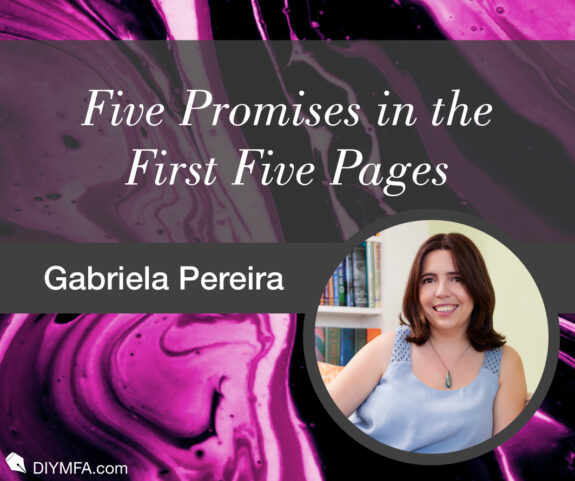Writing a book is like making a contract with our readers. We agree to craft a great story and our readers in turn agree to suspend their disbelief and keep turning pages. Furthermore, I believe that at the start of every book, we must make five promises to our readers. These promises are not hard-and-fast rules (we can break or delay these promises for a desired effect). They are instead more like guidelines that we as writers might follow to help make our books as engaging as possible.
Keep in mind that if we break one or more of these promises, we will stretch our readers’ trust in us. That doesn’t mean that readers will instantly stop reading our books, but simply that the trust between reader and writer has been tested and it will take some time and effort to build that trust back up. If there is a particular effect we want to create, we may strategically choose to break one of these promises, but we must do so with intent and not simply on a whim.
Promise #1: The Character
The first thing we promise to our readers is a character to follow. In most cases, the protagonist of the story appears right away on page one. Sometimes, however, an author might choose to delay that character’s appearance. Think of the way Mr. Darcy, the love interest in Jane Austen’s Pride and Prejudice, doesn’t appear until well into the story. This delay underscores Darcy’s reticent nature and introverted personality. It would not have been true to the character had he appeared right away at the opening of the book.
In a similar fashion, the main character (Bagley) of Tor Seidler’s The Wainscott Weasel does not appear until the second chapter. In fact, when I first read the book, it took me a while to figure out that he was even the main character at all. Since Tor Seidler happened to be my MFA professor at the time, I had the benefit of asking him why he crafted the story in that way. His answer was that Bagley was such a shy character, it would not have been true to his personality to put him front and center on page one. Instead, it made more sense to delay his appearance until chapter two to resonate more with that aspect of his personality.
When it comes to crafting our stories, most of us will introduce the main character right away in the first chapter—perhaps even on the first page. There is no requirement that the main character must appear on page one and we can delay the appearance of that character to a point. That said, we must consider why we are choosing to delay that character’s appearance and we must do so for strategic reasons.
Promise #2: The Voice
I’ve written about voice in previous Writer Fuels so I won’t go into too much detail here. Suffice to say that the opening of a story is where we as writers must establish the voice of the narrative. Who is narrating the story, and how does that narration come across? Is the narrator opinionated and in-your-face? Or is that narrator so subtle they seem almost invisible?
Along with voice we must also consider the point of view. Is the story being narrated in the first person by a character in the story? Or is the narrator an entity outside the story describing the events in third person? Also, how close to the story is the narrator? Are they in the thick of things, or are we viewing the story from a bird’s eye view perspective?
Depending on the point of view we choose, the voice of the story can be different. For example, it is far easier to give the narrator a personality when we write in the first person because the narrator is, by necessity, a character in the story. With the third person, on the other hand, it is much easier to make the narrator feel invisible, especially when we use the omniscient form.
When we promise the voice, we establish for our readers how we will tell the story. Narration is the element of the craft that most directly connects the reader to the story. This is because the narration is what dictates how the reader receives the story. For this reason, it is important that we keep our narration as consistent as possible and only change things up when it serves a strategic purpose.
Promise #3: The World
At the start of every story, we must promise readers the world. Don’t worry, I’m not talking about the whole wide world. I’m talking about your world, the one you’ve created for this story. From the very beginning, we must establish what the world of our story is like and we need to make our readers feel like that world is real.
It can be tempting to use the dreaded info-dump to bring our readers up to speed. Yet throwing too much world building exposition on the page (especially early in the story) will only bore our readers and make them more likely to put down the book. Instead, the key to good world building is to drop the reader into that world and have them follow a character as they navigate through it. When it comes to world building, we must keep our readers on a need-to-know basis, giving them only the information they need to understand the story in that moment. All other details can wait until they become necessary to the story.
Promise #4: The Problem
At some point early in the story, the character will need to face some sort of problem. After all, no one wants to read about happy characters being happy all the time. (That’s boring!) Instead, we need some hint that the character’s world is not perfect and that they will have to overcome at least one obstacle over the course of the story.
Keep in mind that this problem does not have to be directly related to the main conflict of the story (though it can be). Consider the opening chapter of Suzanne Collins’ The Hunger Games. The protagonist, Katniss, goes hunting with her best friend Gale and right away we know that they are facing a big problem. We know that food is scarce for them by the way Katniss reacts when Gale gives her a piece of bread. We also know that there is something scary looming in their immediate future (the Reaping) though we do not know exactly what that thing is. In this case, the problem (scarcity of food and looming danger) is directly related to the central conflict of the story which is whether or not Katniss will survive the games.
In other scenarios, the problem at the beginning of the story is not directly related to the central conflict but affects that conflict in a more indirect manner. Consider the problem at the beginning of Pride and Prejudice. In this case, the problem is that at that time in England, women could not inherit land, which meant that if a father did not have a male heir, the estate would be entailed away from the family to a distant relative. In the Bennet family, where there are five daughters and no sons, this is a very real problem and the best way to secure the family’s future is for one of the daughters to marry well.
This problem regarding the family’s estate is not directly related to the story’s central conflict, which is whether or not Lizzie and Darcy will get together. Yet because the mother, Mrs. Bennet, is so desperate to marry off one of her daughters, she creates circumstances that force Lizzie and Darcy into each other’s company, thus causing their relationship to take root.
Promise #5: The Event
At some point in the first few pages of a novel, something needs to happen. After all, a story cannot exist in a state of stasis. Sooner or later there needs to be an event that kicks off the story and sets things in motion. This event makes it clear why the story starts at this particular point in time and not two weeks before or three days later. There needs to be a reason why you are starting the narrative at this point in the timeline, and that reason is the opening event.
Consider the opening of the film The Wizard of Oz. The very first image we see is of Dorothy running down a dirt road back to her aunt and uncle’s house. We find out soon thereafter that Dorothy’s dog, Toto, had some sort of confrontation with their grumpy neighbor and that did not end well. In fact, the neighbor has called the local authorities and they want to take Toto away. We get the sense that this conflict with the neighbor is nothing new and that Toto has gotten into the neighbor’s yard many times in the past. The difference now is that this is the day when things are a little bit different. This is the day when Dorothy might actually lose Toto.
Similarly, both in Pride and Prejudice and The Hunger Games, the story begins on the day where everything changes. In Pride and Prejudice, the story begins with the arrival of an eligible bachelor who has moved into the house next door to the Bennets. In The Hunger Games, we don’t see weeks and weeks of Katniss and Gale living in District 12 and fighting to survive. Instead, the story starts the morning of the Reaping—and not just any Reapling, but the one where Katniss’ little sister Prim has her name in the lottery for the first time.
Ultimately, these promises are about building trust with your readers. Yes, we can stretch that trust at times, but we need to have a good reason for doing it. Remember that most readers are rooting for you—they want your book to be good—which means they’re willing to go along for the ride when you try something that pushes the envelope. Just make sure that when you take those creative risks, it’s with an eye toward making the story as good as possible. Every time you consider breaking one of these five promises, ask yourself: “Will this make my story the best it can possibly be?” If the answer is YES, then go for it! But if the answer is NO, you may want to reconsider. At the end of the day, it’s all about writing a good story.
Until next time, keep writing and keep being awesome!

P.S. For more info on Gabriela Pereira, the founder and instigator of DIY MFA, check out her profile page.







